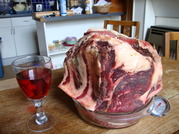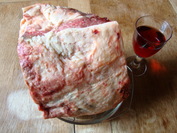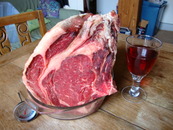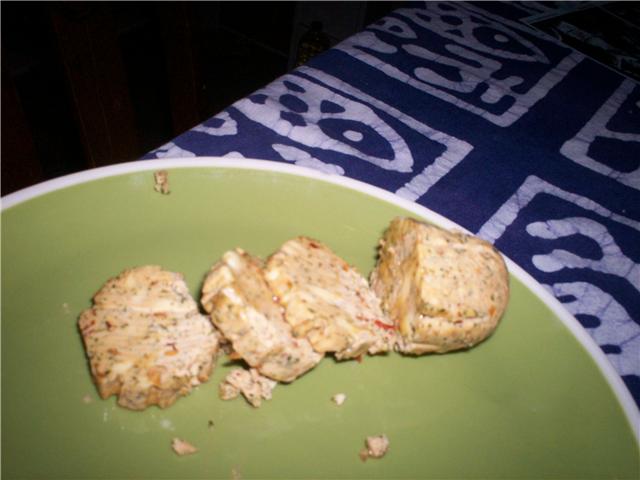Steak And Chips - Spring 2010
I invited my friends Aidan and Jude over for Saturday dinner,
and having palmed off the girlies on her Mum, Rachel is coming over stag also.
It's our chance to try and get our relationship back on track after the annual winter blues -
safe in the company of friends to prevent us from bitch slapping each other to death.
Should be a fun evening.
I told Jude that I'd be making something non-fussy. Steak And Chips I said.
Jude thought that sounded like a good idea.
"It will be nice to do something simple" she said.
"You can have a nice relaxing evening" she said.
So I figured I would only need a week's preparation,
and to get the ball rolling the Saturday before I made myself a lovely
sirloin with port jus,
green beans, shallots, garlic and anchovies,
and
mushrooms with Sambuca and soy sauce.
Mouth-Achingly delicious. I hope next week's performance is as good.
It was quite handy working through the side dishes -
I discovered that not only can you completely prepare the mushrooms and keep them warm,
covered, in the bottom of the oven for any length of time but it actually seems to improve the flavour.
You can leave the cooked shallots sitting in the oven until required also.
Now this being Monday, I've got my
menu mostly planned,
and I'm working on my
shopping list and cooking
schedule.
First Slaughter Your Cow...
Or get a butcher who has his own farm to do it for you...
Côte de Boeuf or Prime Rib Roast
Ingredients:
- Beef - Prime Rib or Côte de Boeuf
My fellow code monkey
John recommended
John Lawson in
Uphall, Edinburgh as the butcher with the mostest, so there I went for my gargantuan piece of cow meat.
I have the very fondest memories of sharing Côte de Boeuf with my Mum at
Les Halles
pavement-side tables on Park Avenue New York
and since reading Anthony Bourdain's
reminiscences
of his time there, I've wanted to recreate the experience.
I couldn't really remember how many ribs we had in our Côte, but I figured two ribs should be enough to feed 4 people
(or even five when
Jenny unexpectedly joined us).
In fact, it turns out that two ribs would feed about 8 people and their dogs
(how on earth Mum and I managed to demolish even a single rib is now a mystery - maybe it was a miniature cow),
but better too much than too little, right?
Despite the butcher not really knowing what I meant by "Côte de Boeuf" when I explained it was just a prime rib roast
he soon pulled over an entire half of a cow and proceeded to saw off the bit I needed.
And the bit I needed was an absolute
monster joint of meat, weighing in at 9½ lbs.
Slightly disappointingly the ribs were trimmed right back, unlike the steaks at Les Halles,
but perhaps that's just the French way of cutting the joint?
It's a pity, because those great curving horns of bone would have provided a very handy rack to sit the joint on,
and would have saved me the trouble of knitting scaffolding out of string to hold the beef in place,
Still the meat looked (and smelt) just the part. Beautifully marbled. Aged to a perfect deep burgundy.
Deciding exactly how to cook it was the next challenge, now I had an idea of its size and weight.
I found a handy
website for Prime Rib cooking times,
and combining that with scouring my meat-oriented cookery books, I decided on the following:
- Preheat the oven
- Get that oven up to 230°C/450°F/Gas 8
- Pan Searing
-
Fire up Rachel's new cast iron Le Creuset skillet that some kind benefactor bought her for Christmas
until it is too hot to hold your hand near, then sear each side of the monster joint until nice and crisped.
About 4 minutes per side. I repeated the searing on the cross-cut sides to get a nice checkerboard pattern.
Make sure you have the windows open and your extractor fan on full blast.
- Oven Seal
- Sit the joint back in the skillet, stick the whole thing in the oven and give the joint a blast of full heat for 20 minutes.
- Oven Roast
- Turn the oven down to a gentle 170°C/325°F/Gas 3 for 10 minutes/lb which means 1½ hours for this bad boy.
- Rest
- Everyone agrees your meat needs a nice rest after all that hard cooking. 15 minutes covered with foil out of the oven.
- Keep warm
- Turn off the oven,
leave the door ajar while the meat rests, then keep the joint warm in the now cooled off oven until required.
I had sensibly bought myself a meat thermometer to make sure I wasn't going to poison everyone, (or worse yet, overcook the meat),
and I was getting a bit worried towards the end of the 90 minutes cooking time that the joint seemed to be a long way off reaching
135°F internally - the perfect temperature for raw and bloody steaks.
So I turned the heat up to Gas 4 for the last 15 minutes or so.
In fact, since I overran my hopelessly optimistic cooking
schedule by around an hour, I needn't have worried.
Possibly the outside of the joint was a little dry and over-cooked. Perhaps both pan-frying
and hot searing was unnecessary?
The meat came out medium rare, which was a bit of a disappointment to the more bloody minded of the party [Aidan], but still had a hint
of pink and
was beautifully tender.
The syllabub and the breakfast baps went according to plan, and all seemed to be running on time until it came to the heavy prep work:
preparing the vegetables for the risotto, the vinegar reduction for the Béarnaise, the chips and the anchovy mixture for the green beans.
I somehow utterly underestimated the amount of time for cleaning, peeling, slicing and dicing.
To say nothing of getting around to cleaning the mushrooms, opening the oysters or topping/tailing the green beans.
I think next time around I might have to plan 10 minutes or so for preparing each vegetable.
Shallots particularly are surprisingly fiddly - they are, after all, quite small.
Also, it takes quite a long time to get 3 litres of oil up to frying temperature, so it will be worth getting that going earlier on next time.
Simply followed John Torode's
recipe, making a half quantity
(and almost screwing up the liquid quantity as a result of being unable to divide by 2)
and dividing into 8 rolls on a single heavy baking sheet so there'd be enough to go around.
Went completely smoothly with the recipe timings being just right.
These baps really are "best" too. Light, fluffy, full of flavour. Delicious.
I made up a double quantity of the
Mushrooms in Sambuca and Soy sauce first,
and set those to sit uncovered
in the warm oven with the roasting shallots and garlic bulb, where they thickened and marinated nicely while we munched our oysters.
After we'd finished our starters I whisked up a single quantity of
Béarnaise sauce
using 8 oz clarified butter and poured it into a pre-heated wide-mouthed thermos flask that I bought in Tesco for the very purpose.
I may have been a bit heavy handed with the vinegar
and the shallots (even though I didn't use all I had prepared).
It was a
teeny bit sharp, but otherwise fine and the thermos kept it warm without setting.
Next I fried up the chips I had previously thinly sliced into a bowl of iced water and set aside.
I used a candy thermometer and the repeated frying method outlined in my other
Steak 'n' Chips page:
first frying at a lower temperature (around 140°C) then working up to a 190°C finish.
In fact, because I had
sooooo many chips, it took four fryings to get them all cooked nicely through,
and the last round
slightly overcooked them so they looked a tiny bit too darkly frazzled.
It would have helped enormously to have a chip basket, rather than having to spend the inordinate amount of time
required to scoop them out with a slotted spoon.
During the final batch of chip frying I set the green beans to boil and when they were cooked and drained
mixed up a half batch of St John Restaurant's
Green Beans, Shallots, Garlic and Anchovies
using 450g beans.
I decided on a combination of double quantities of Grecky's
syllabub recipe
(which I had tried and was therefore confident it would work,
plus I felt the yoghurt would give it a pleasant sharpness at the end of such a heavy meal),
and Marco Pierre White's
Limoncello poached lemon slices.
The lemon slices were not quite so popular [Aidan!], and I certainly could have made half the quantity, and probably added more sugar,
but they added an interesting contrast to the creamy syllabub. All in all, not too bad. And very pretty.
I poached the 2 sliced lemons the night before and left them in the fridge, making the rest of the syllabub in the morning.
I think this was a wise choice - there was a slight film of moisture building up on the syllabubs by mealtime so I don't
think they would have survived a night in the fridge quite so well without covering.
The poached lemon was a little soggy for decoration, I thought, so I used a small pile of lemon peel parings instead.
And there you have it.
A nice simple Saturday night dinner.
Seemed to go down pretty well,
I have half a roast Beef
leftover for sandwiches,
stir-fries or curries for the rest of the week,
plus I've scored 3 bottles of red wine and a scarf.
Anyone leave their scarf?
By Karl
Sirloin With Port Jus
main meat
Perfect for one.
a beautifully marbled and perfectly aged hunk of sirloin from your favourite
butcher
extra virgin olive oil
salt & pepper
glass port
½ cup reduced beef stock that you happen to have
made earlier
Get the steak out of the fridge in plenty of time to warm through thoroughly.
Put a plate or serving dish in the bottom of the oven.
Rub generously with olive oil, then grind over salt and pepper.
Heat a cast iron griddle until it is uncomfortable to hold your hand close to.
Slap the steak onto the griddle and leave it alone, smoking and crackling, until the side has charred nicely, about 2 minutes.
You can rotate it if you want a nice criss-cross pattern
Turn the steak over when it's done and repeat with the second side.
Place the steak on the warming dish, cover and leave to sit in a warm place for 10 minutes while you finish off the sauce and vegetables.
Pour the port into the griddle and let it bubble off, then add the stock.
Scrape around the griddle and reduce until thickened, whisking in a few knobs of butter to finish.
Pour the lovely rich sauce over the steak and serve with baked potatoes and veggies.
By Karl
Lemon Risotto with Tempura Oysters
starter fish
This is a rather nice way of serving the lemon risotto.
I adapted the tempura batter recipe from Will Ricker's
Eastern & Oriental Cookbook
using iced Cava instead of sparkling water:
It's simple and worked perfectly well.
I'm not really sure how it compares with others, but maybe we can do a cook-off some time?
ice-cold Cava
6 frozen disks of
chilli parsley butter
1 dozen oysters
2 portions
lemon risotto from 1 cup rice
60g cornflour
60g plain flour
groundnut oil for deep-frying
Slice the chilli parsley butter roll into fat disks with a hot knife,
and set them on a plate in the freezer.
Open up the oysters and clean the bodies of all the shards of broken shell.
If you are running hopelessly behind schedule you can challenge your guests to open their own oysters,
just be sure you have plenty of bandages and
TCP standing by...
Make your lemon risotto and set aside, covered, in a warm place.
Blend the flours together.
Roughly stir in enough Cava to make a gloopy batter.
Heat the groundnut oil to 185°C
Dip the oysters in the batter and throw them into the oil.
Scoop them out and drain them on kitchen roll when they start to colour, which will only take a minute or so.
To serve, ladle risotto into bowls, top with a disk of butter and pile an oyster or two on top.
Deliver immediately to the table before the butter melts.
By Karl
Chilli Parsley Butter
ingredient veg
Serves 8
Butter
1-2 Smoky dried chillies, such as Ancho
wine vinegar
a handful chopped curly parsley
a few puréed garlic cloves (optional)
salt
Mash some room temperature butter until soft and fluffy.
Tear the dried chilli flesh into pieces, discarding the seeds and stalks.
Cover them in a non-aluminium pot with a little vinegar (diluted if you like) and simmer until softened.
Put the chilli mixture into a food processor and blend until the chillies are chopped finely enough for your taste
.
Thoroughly mash the chilli mixture, a little seasoning, the chopped parsley and, if you like, some pressed garlic with the remaining butter.
Spread a sheet of clingfilm on a flat surface and spoon the butter mixture into it.
Then roll the mix up in the film and roll back and forth to form a smooth log 1" or 2" inches wide.
Refrigerate.





